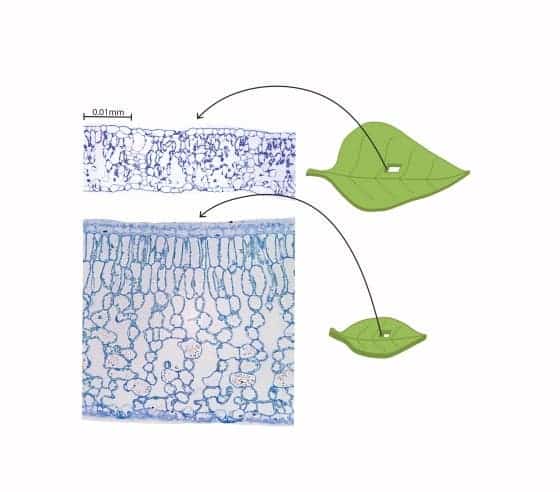After performing an exhaustive quantitative research across numerous plant species, scientists at UCLA’s College of Letters and Science have found that leaf design is governed by a set of fundamental mathematical expressions, underling once again the elegance of nature.

Credit: Lawren Sack, Grace John, Christine Scoffoni/UCLA Life Sciences
The basis of their research was “allometric analysis”, that is to say the study of an object’s evolution in size by studying its constituting parts and how they vary in proportionality. While it is easy to observe major differences in leaf surface area among species, they said, differences in leaf thickness are less obvious but equally important. Leaf thickness is actually where the researchers struck gold.
Once you start rubbing leaves between your fingers, you can feel that some leaves are floppy and thin, while others are rigid and thick,” said Grace John, a UCLA doctoral student in ecology and evolutionary biology and lead author of the research. “We started with the simplest questions — but ones that had never been answered clearly — such as whether leaves that are thicker or larger in area are constructed of different sizes or types of cells.”
A leaf is made out of three distinct parts: the outer layer that makes the leaf surface also called an epidermis, the mesophyll which is comprised of photosynthesis capable cells and vascular tissue, whose cells are involved in water and sugar transport. The team found, after cutting cross-sections thinner than a single cell to observe each leaf’s microscopic layout, that the thicker the leaf, the larger the size of the cells in all of its tissues — except in the vascular tissue.
These relationships can be described by new, simple mathematical equations, effectively allowing scientists to predict the dimension of cells and cell walls based on the thickness of a leaf.
“This means that if a leaf has a larger cell in one tissue, it has a larger cell in another tissue, in direct proportion, as if you blew up the leaf and all its cells using Photoshop,” said Christine Scoffoni, a doctoral student at UCLA and member of the research team.
The new ability to predict the internal anatomy of leaves from their thickness can give clues to the function of the leaf, because leaf thickness affects both the overall photosynthetic rate and the lifespan, said Sack.
“A minor difference in thickness tells us more about the layout inside the leaf than a much more dramatic difference in leaf area,” John said.
“Fundamental discoveries like these highlight the elegant solutions evolved by natural systems,” Sack said. “Plant anatomy often has been perceived as boring. Quantitative discoveries like these prove how exciting this science can be. We need to start re-establishing skill sets in this type of fundamental science to extract practical lessons from the mysteries of nature.
“There are so many properties of leaves we cannot yet imitate synthetically,” he added. “Leaves are providing us with the blueprints for bigger, better things. We just have to look close enough to read them.”
“What makes the cross-sections especially exciting is the huge variation from one species to the next,” John said. “Some have relatively enormous cells in certain tissues, and cell shapes vary from cylindrical to star-shaped. Each species is beautiful in its distinctiveness. All of this variation needs decoding.”






